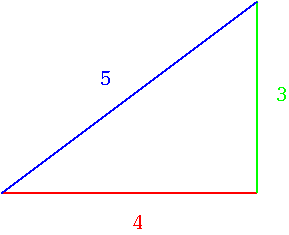On-line Math 21
On-line Math 21
Special right triangles
There are ``special'' right triangles, all of whose sides are integer
lengths. The simplest is a ``3-4-5'' triangle, whose side lengths are,
respectively, 3, 4, and, um, 5. These correspond to the coincidence that
so these must be the sides of a right triangle.
 Of course, if you multiply each of these numbers by, say, 2, the relationship
between them will still hold, so you have ``6-8-10'' or ``9-12-15''
right triangles as well. These triangles occur a lot in related-rates problems,
and it should be a signal that you are approaching such a problem correctly
when you see one.
Of course, if you multiply each of these numbers by, say, 2, the relationship
between them will still hold, so you have ``6-8-10'' or ``9-12-15''
right triangles as well. These triangles occur a lot in related-rates problems,
and it should be a signal that you are approaching such a problem correctly
when you see one.
The other common triangles that fit this pattern are ``5-12-13'' triangles.
Again, since
these are the sides of a right triangle. There are actually infinitely many
distinct such ratios (not counting a ``10-24-26'' as distinct from
a ``5-12-13''), but these two are the only ones you're likely to see in
these problems, or that you are likely to recognize.
As a real aside, it is curious that this equation
has so many solutions, with x , y and z integers. If you
ask naively whether similar equations have solutions like that, you might consider
the equation
and ask how many solutions it may have, with x, y, and z
all positive integers. This is one of the most famous equations in mathematics,
all the more curiously because it was the assertion that it has no solutions
(for n > 2 , and x, y, and z all positive integers)
that made it so famous.
The statement that the equation
had no solutions for x, y , and z positive integers, n > 2
a positive integer as well, has been known for 350 years as Fermat's Last Theorem.
He claimed to have proved this fact when he wrote it down in the margin of a
text, saying regrettably that: ``I have discovered a truly remarkable proof
which this margin is too small to contain.''
Well, that margin would have had to be pretty large indeed, it turned out. This
``theorem'' was one of the most celebrated open problems in mathematics
for hundreds of years. Many partial results (for some values of n , or
some arithmetical relationships among x, y, z and n ) were
shown, and vast mathematical industries sprung up around the questions surrounding
this problem. It wasn't until 1994 that Andrew Wiles, at Princeton University,
completed a chain of results linking this theorem to other, previous, theorems.
See, for example, Fermat's Last Theorem
for a good explanation of the result, and a brief synopsis of Fermat's life.
Copyright (c) 2000 by David L. Johnson.
File translated from
TEX
by
TTH,
version 2.61.
On 24 Nov 2000, 17:44.

